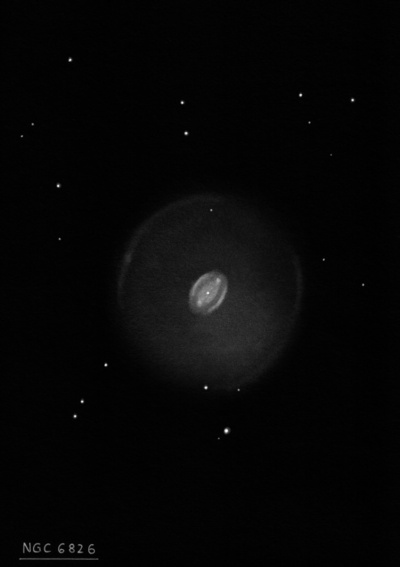Blinking Planetary
Blinking Planetary

William Herschel discovered NGC 6826 = H IV-73 = h2050 on 6 Sep 1793 (sweep 1049) and recorded "a beautiful phenomenon. A bright point, lE, like two points close to one another; as bright as a star of the 8-9 magnitude surrounded by a very bright milky nebulosity suddenly terminated, having the appearance of a planetary nebula with a lucid center. The border, however, is not very well defined. It is perfectly round and I suppose about 1/2' in diameter. It is of a middle species between the planetary nebula and nebulous stars." JH recorded "a most curious object. A * 11m surrounded with a vB, perfectly R planetary nebula, of equal light throughout. Diameter in RA = 3.5 sec. Perhaps a little hazy at the edges. With 320x the * is not seen double."
On 28 Aug 1850, Bindon Stoney recorded at Birr Castle, "A very remarkable object, probably analogous to h450 [NGC 2392]. The dark ring is not easily seen, but there can be no mistake about it, seen by Lord R and myself, my brother (George Stoney) saw it dark under [preceding] the central star." Observing with a 9.5" refractor at 760x in 1856, Father Secchi described (and sketched) the outer halo resolving into a number of small stars and claimed it was an open cluster (AN 43, 157).
Based on Crossley photographs at Lick, Curtis (1918) wrote "The central star...is surrounded by an oval disk of bright matter 27"x24". Within this are rather obscure evidence of a brighter ring formation, the condensations at the ends of which are 22" apart in p.a. about 125°." An outer shell of 110" in diameter was first photographed with the 100-inch at Mt Wilson on 13 Aug 1936. It was looked for after finding an unsuspected outer envelope around M57.
The Herschels never mentioned a blinking effect, though it is less prominent in larger scopes. In an article titled "Suggestions to Amateurs: Nebulae and Clusters" by Lewis Swift in Popular Astronomy (1894) he mentions, "According to Professor Mitchell, "now you see it, and now you don't". The blinking effect was noted by James Mullaney and Wallace McCall in the August 1963 issue of Sky & Tel, though the nickname was coined by Mullaney.
200/250mm - 8" the famous "blinking" planetary blinks well with this aperture. Contains a bright mag 10 central star (HD 186924) visible with direct vision and the outer nebulosity dominates with averted vision.
400/500mm - 17.5" (8/17/01): beautiful view at 500x; the disc is slightly elongated WNW-ESE, with subtle structure. There is small, slightly darker region around the bright 10th magnitude central star. The halo appears to dim slightly along the preceding edge and this edge is not as sharply defined. Located 28' E of the double star 16 Cygni.
17.5" very bright 25" roundish nebula surrounding a bright 10th magnitude central star, slightly elongated ~E-W, high surface brightness. With direct vision the planetary appears brighter on the south side. The planetary is too bright with this aperture to have the striking "blinking" effect seen with smaller apertures.
600/800mm - 24" (9/13/12): at 325x the main 30" disc appeared slightly brighter in the east-southeast region. Adding an H-beta filter, a very small knot was sometimes visible near the rim at the east edge. This difficult knot is prominent on the HST image as a red FLIER (Fast Low-Ionization Emission Region). The corresponding knot on the west edge was not visible. The red color of these FLIERS is from ionized nitrogen and it disappeared switching to an OIII filter, although the large outer halo became visible.
24" (8/16/12): at 300x and an OIII or NPB filter, the main high surface brightness disc (slightly elongated) is surrounded by a very faint, fairly uniform giant halo, extending 2' diameter and quadrupling the size of the bright 30" disc! The outer halo seemed perfectly round with a well-defined edge and was easily visible.
900/1200mm - 48" (10/27/16): at 610x and 813x; both internal FLIERS (see observation below) were visible on the NW and SE sides of the central disc. The disc had a slight bulge on the northwest and southeast ends creating a slightly elongated, irregular oval NW-SE. A fainter inner halo was visible at 610x, roughly doubling the size. At 244x and NPB filter, a third large outer shell was fairly prominent forming a well defined 2' circular halo.
Notes by Steve Gottlieb